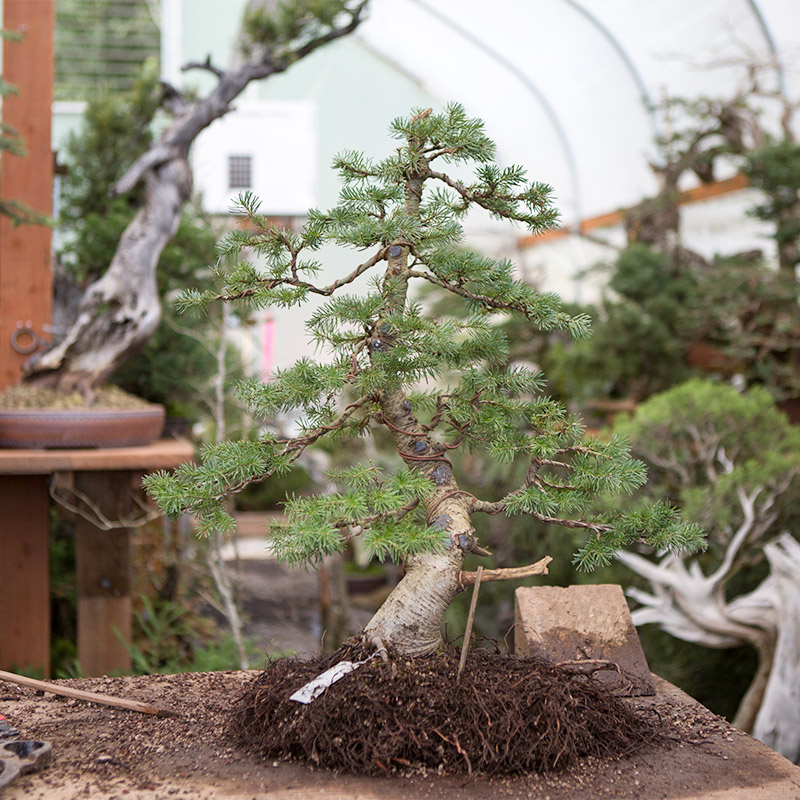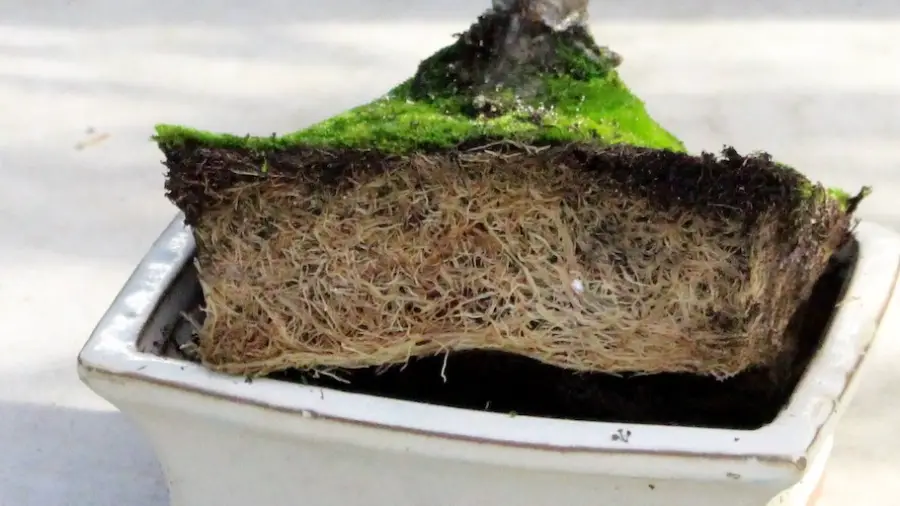Repot pine bonsai every 2-5 years in early spring. Ensure the tree is healthy and showing signs of root-bound conditions.
Repotting pine bonsai is crucial for maintaining its health and aesthetics. Early spring is the ideal time for this task. This period allows the bonsai to recover quickly and establish new roots before the growing season. Check for signs like roots growing out of the drainage holes or the soil drying out too quickly.
When to Repot Pine Bonsai: These indicators suggest it’s time for repotting. Use a well-draining bonsai soil mix to ensure proper aeration and moisture balance. Regular repotting helps prevent root rot and promotes vigorous growth. Consistent care and timely repotting will keep your pine bonsai thriving and looking its best.

Credit: www.bonsaitree.co.za
Table of Contents
Signs Your Pine Bonsai Needs A New Home
Yellowing needles, stunted growth, or roots circling the pot signal your pine bonsai needs repotting. Fresh soil and more space rejuvenate its health.
Roots Circling The Pot
Roots growing around the pot’s inner edge is a clear sign. The pot looks crowded with roots. This restricts the plant’s growth. Roots circling the pot means the bonsai lacks space. Fresh soil and a larger pot can help. Healthy roots should spread freely. A root-bound plant suffers stress. Repotting gives the roots room to breathe.
Slow Growth Patterns
Bonsai growing very slowly might need repotting. Limited space stunts the growth. Fresh soil provides new nutrients. Lack of growth signals the need for repotting. Observe the growth rate closely. A healthy bonsai should grow steadily. Repotting helps in maintaining proper growth. Ensuring the right pot size is crucial.

Credit: bonsaimirai.com
Best Season For Repotting Pine Bonsai
Spring is the best time to repot pine bonsai. The tree starts to grow new roots. This growth helps the tree recover quickly. The weather is mild and gentle. This is good for the tree’s health. Repotting in spring gives a head start for the growing season. Fresh soil and space boost growth and health. The tree can establish itself before summer heat arrives. Spring repotting minimizes stress and maximizes benefits.
Autumn repotting is a good alternative if spring is missed. The tree is preparing for dormancy. This means less stress during the process. Cooler temperatures help reduce shock. Fresh soil helps the tree through winter. Autumn repotting ensures the tree is ready for spring growth. The tree can settle in before winter cold hits.
Choosing The Right Pot For Your Bonsai
The pot size must match the tree size. A small tree needs a smaller pot. A large tree needs a larger pot. The roots need space to grow. Too small a pot can harm the tree. The pot should be neither too big nor too small.
The pot material is important. Clay pots are common. Plastic pots are lightweight. Each material has pros and cons. The pot must have drainage holes. Water should flow out easily. Good drainage prevents root rot. Healthy roots mean a healthy bonsai.
The Repotting Process Step By Step
First, gently loosen the soil around the bonsai. Use a small rake or chopsticks. Carefully lift the tree from its pot. Avoid pulling it by the trunk. This can damage the roots. Support the root ball with your hand. Remove any old soil stuck to the roots. Inspect the roots for any signs of disease or rot.
Trim the roots to encourage new growth. Use sharp scissors or shears. Remove any dead roots you find. Cut back long roots to fit the new pot. Leave a healthy root mass for stability. Avoid over-pruning to prevent stress on the tree. Work slowly and carefully for best results.
Choose a soil mix that drains well. Pine bonsai prefer a mix of akadama, pumice, and lava rock. Ensure the soil has good aeration. Avoid compacted soils which can suffocate roots. A balanced soil composition supports healthy growth. Mix the components thoroughly before use.
When to Repot Pine Bonsai: Aftercare Following Repotting
Water the pine bonsai immediately after repotting. Use a gentle stream of water. Ensure the soil is moist but not soggy. Avoid overwatering. Overwatering can harm the roots. Check the soil daily. Water only when the top layer feels dry.
Place the pine bonsai in a shaded area after repotting. Protect it from direct sunlight. Direct sunlight can stress the plant. Gradually introduce it to more light. Increase sunlight exposure each day. Ensure it gets enough light after a week.
Common Mistakes To Avoid During Repotting
Over-pruning roots can harm your pine bonsai. It weakens the tree. Always prune roots with care. Remove only what is necessary. Keep the healthy roots intact. Too much pruning shocks the tree. It may stop growing. Use sharp, clean tools for pruning. Dirty tools can cause infections. Healthy roots mean a healthy bonsai.
Using the wrong soil mix can be disastrous. Pine bonsai needs well-draining soil. Poor soil can lead to root rot. Ensure the soil mix has good aeration. This helps the roots breathe. Avoid using garden soil. It is too dense and retains water. A good mix contains akadama, pumice, and lava rock. This mix promotes healthy root growth.
Frequency Of Repotting Pine Bonsai
Young pine bonsai need repotting every 1-2 years. Older trees can wait 3-5 years. Small bonsai need more frequent repotting. Larger bonsai have more room for roots. Check root health to decide repotting time. Healthy roots mean a healthy tree. Repotting too often can stress the tree. Not repotting can cause root-bound issues.
Different pine species have unique needs. Japanese Black Pines need repotting every 2-3 years. Japanese White Pines prefer 3-4 years. Scots Pines usually need 3-4 years. Mugo Pines can go 4-5 years. Check species-specific guides for best practices.
Benefits Of Regular Repotting
Repotting pine bonsai every two to three years ensures healthy root growth and prevents the plant from becoming root-bound. This practice helps maintain optimal soil conditions, promoting overall plant vitality and longevity.
Healthier Root System
Repotting helps maintain a healthy root system. It prevents roots from becoming too crowded. Fresh soil provides new nutrients. This allows the bonsai to grow better.
Repotting also removes old and decayed roots. This encourages the growth of new, healthy roots. A healthy root system supports the entire plant.
Visual Aesthetics Enhancement
Repotting can improve the look of your bonsai. Fresh soil looks cleaner and tidier. A new pot can also enhance the overall appearance.
Regular repotting keeps the bonsai compact and beautiful. It helps maintain the desired shape and style. This makes your bonsai more attractive.

Credit: bonsaitonight.com
Frequently Asked Questions
How Do You Know When Your Bonsai Needs Repotting?
Check for roots circling the pot’s bottom. Soil drying out quickly also indicates the need for repotting.
When To Repot A Pine Tree?
Repot a pine tree in early spring before new growth begins. Ensure the roots are not crowded. Use well-draining soil.
When To Repot A Conifer Bonsai?
Repot a conifer bonsai every 2-3 years in early spring. Ensure the roots are not overcrowded. Use well-draining soil.
When To Repot White Pine Bonsai?
Repot white pine bonsai in early spring before new growth starts. Check root health every 2-3 years. Use well-draining soil.
Conclusion
Repotting your pine bonsai at the right time ensures healthy growth and vitality. Spring is ideal for this task. Regularly check the roots and soil condition. Using proper techniques will help maintain a thriving bonsai. Follow these tips to keep your pine bonsai in top shape and enjoy its beauty for years.
